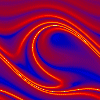

 |
|||
 |
|||
|
|
Unlike the logistic map or the Hénon map, the Lorenz equations represent a time continuous system. Edward N. Lorenz introduced these equations [Lorenz63] as an approximative model of the Rayleigh-Benard-experiment (see there for an explanation of the parameters) .
If two of the system parameters are set to the frequently used values For 0 < R < 1 the origin (0,0,0) is a globally stable fixed point. At R=1 this fixed point becomes unstable and two new stable fixed points C+ = ((b(R-1))1/2, (b(R-1))1/2, R-1) and C- = (-(b(R-1))1/2, -(b(R-1))1/2 , R-1) arise. The basins of attraction of these two fixed points are separated by the stable manifold of the now unstable fixed point at the origin. At R=Rho=13.926... this stable manifold contains a homoclinic orbit and there is a dramatic change of its topology for R>Rho . Then in the upper half space, Z>0, there is an infinity of dense leaves which are interwoven in a complicated way, see figures in [Jackson85]. At the same time a countable infinity of unstable periodic orbits arises. At R=24.74... both fixed points C+ and C- become unstable by a Hopf bifurcation and the Lorenz attractor appears. Not all the solutions of the Lorenz equations for R > 24.74... are chaotic, but there exist ranges of R with stable periodic orbits. In these windows period doublings can be observed. These bifurcations here occur for decreasing values of R, finally leading to chaos at the lower border of the window. The table lists values of R in three windows [Sparrow82], the symbol P denotes one circulation around C+ , N denotes one circulation around C-:
Other three-dimensional examples of autonomous differential equation systems which exhibit chaotic attractors, too, are the Chua oscillator, the Roessler system or the Rabinovich-Fabrikant equations.
Literature
Besides the monography [Sparrow82] and the article [Jackson85]
many informations about the Lorenz system which is introduced in [Lorenz63] are provided in [Guckenheimer83] or [Schuster88]. For which Rayleigh numbers
do periodic solutions exist and for which do chaotic solutions exist? This question is investigated in [Morioka78] and [Shimizu78]. For the limit of large Rayleigh numbers [Shimuzu79] introduces a method to calculate analytically a constant of motion of the (dissipative!) system and to derive a simple unstable periodic orbit. In [Froyland84] the dependence of the largest Lyapunov exponent on the Raleigh number is investigated numerically. For the fixed value
|
|
|
|
|
|
||||||||||||||||
| privacy statement |